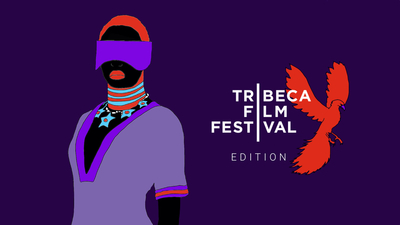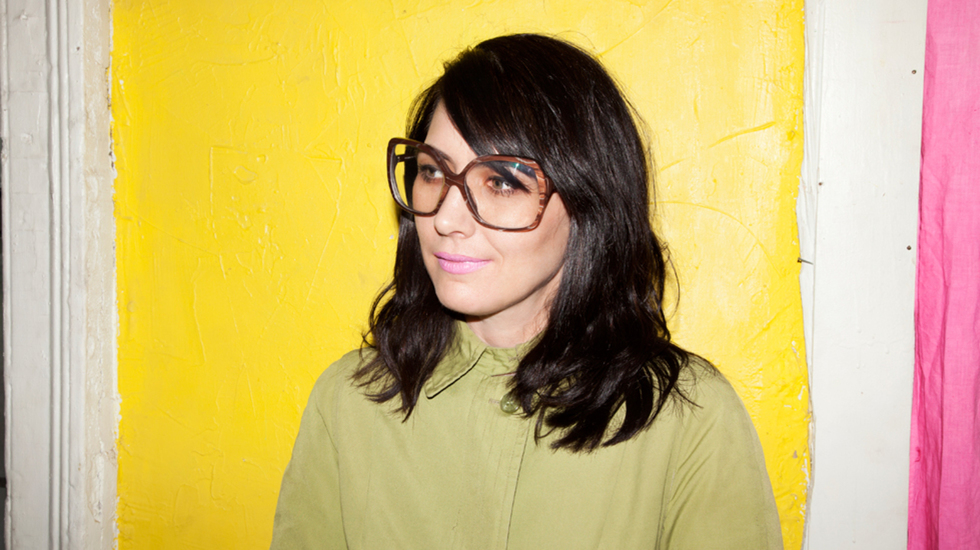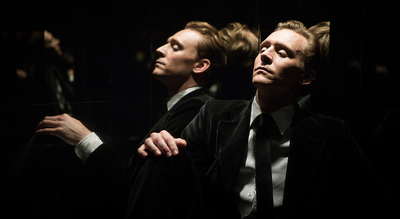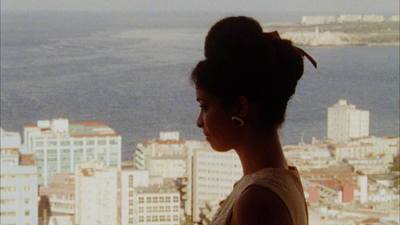
BY KAREN KEMMERLE |
All Girls to the Front: Sini Anderson Talks ‘The Punk Singer’ and Kathleen Hanna
Riot Grrrl pioneer Kathleen Hanna, the front woman of Bikini Kill and Le Tigre, is at long last the subject of a documentary from punk rock feminist/filmmaker Sini Anderson.

Sometimes the only way to let your voice be heard is through the art you create. Sini Anderson’s intimate documentary, The Punk Singer, explores the life of punk rock feminist and musician Kathleen Hanna who has indeed let her voice be heard.. From her early days as the frontwoman of Bikini Kill to her mysterious disappearance from the spotlight in 2005, the documentary features clips of over 20 years of archival footage and revealing interviews with stars like Joan Jett, Kim Gordon, Carrie Brownstein and Hanna herself.
We had the pleasure of sitting down with filmmaker Sini Anderson to talk about her friendship with Hanna, the double-edged sword of crowdfunding and the most important lesson she learned while making The Punk Singer.
Tribeca: The first time I ever heard of Kathleen Hanna & Bikini Kill was when I saw 10 Things I Hate About You. It was among the bands Julia Stiles’ character mentions as her favorites.
Sini Anderson: Really? [laughs] That’s hilarious. Julia Stiles actually introduced Bikini Kill to one of my exes! She actually went to summer camp with her. For their talent show, Julia Stiles made my ex go in the bathroom and learn “Feels Blind” and then perform it on stage.
Tribeca: So in a way, Julia introduced both of us to Bikini Kill!
SA: There you go. Julia Stiles is helping bring Bikini Kill into the mainstream. I wonder if she’ll see our little movie.
Tribeca: You should tweet her.
SA: Maybe right after this interview!
Tribeca: Do you remember your own first experience with Kathleen Hanna and Bikini Kill?
SA: I was living in Chicago at the time. I hadn’t heard of them yet because I was a little more into the hip hop scene. I was actually a break dancer. I remember wandering the streets of Chicago one night, and I heard all this noise coming out of a club with all these chicks out front. I kind of pushed my way in and there was a Bikini Kill show going on. I couldn’t believe what I was seeing. My jaw just hit the floor.
These chicks were up there—just totally taking control—and they had so much energy. I had been to punk shows before, but I’d never seen a female front person like that. Shortly after that, I moved to San Francisco and really started to get into Bikini Kill from there.
Tribeca: I was really struck by the opening of The Punk Singer: “It was the middle of the night in my house. I’m your worst nightmare come to life because I’m not going to shut up. I’m going to tell everyone.” At that point, she was already starting to experiment with rhythm. Were you aware of Kathleen’s spoken word origins?
SA: You know, I wasn’t, until we became friends. I actually used to be a part of this all-chick spoken word group called “Sister Spit” in San Francisco during the 1990s. We used to talk about spoken word, but I hadn’t seen any of her work in that genre until I started making the film. It was very clear from the footage that she should have been singing in a band.

Tribeca: When you think “Punk Rock Feminist,” there’s a certain stigma that comes with that label. You don’t expect Kathleen to be as funny, and warm, and loving, as she is. Were you pleased to be able to show that side of her to the public?
SA: Totally, but that’s the Kathleen I’ve known and loved! All my best friends are these incredible punk rock feminists, and they’re the funniest people that I know. Perhaps I’m biased! However, there’s this assumption that because you’re a powerful female with a strong message that’s all you are. You can’t be funny or sweet or even vulnerable. So it’s great to see someone like Kathleen relax out of her message for a minute and be this hilarious person.
Tribeca: In addition to showing Kathleen’s activism and musical prowess, the film also documents the dangers of undetected Lyme disease. Did you set out to do that or did it just happen naturally?
SA: I mean, it’s her life, right? We documented her life experiences for a time, and Kathleen made the decision to be honest and public about her opinions—whatever they may be. Kathleen has this incredible willingness to share these really difficult parts of her experiences, knowing that her candor is going to help someone on the other end. Of course, a lot of the issues she’s faced over the course of her life are really serious, but she’s super smart at being able to put a twist on her difficulties that makes her story a little bit more fun too.
Her music has a message—but it’s something you can dance to. Art is the best way to push a movement. If it’s just the hardships, if it’s just the politics, it can get exhausting. She does a really great job of mixing her music and energy, her fashion, and her Valley Girl accent in with all of these brilliant topics.
We need to let women tell their stories. We tend to doubt ourselves.
Tribeca: I was really struck by the lo-fi look of The Punk Singer, especially with some of the interviews— the pink lighting and the plaid curtains were wonderful. How did you determine the look of the documentary?
SA: Originally, I wanted the documentary to happen seasonally. The interviews you’re referring to actually took place in the back of a van at a Kathleen Hanna tribute show that happened at the Knitting Factory. The event is featured in the film. There were 21 bands that performed covers of her songs, and we interviewed them directly afterwards.
It was actually right before Christmas, which partially explains the Christmas lights and plaid. [laughs] After each band performed, they would jump into the back of the van. We had five cameras rolling and just cranked through those interviews all night. We talked to some really amazing women too—Joan Jett, Kim Gordon, Tavi Gevinson, to name a few. The whole thing felt really appropriate because it was pretty punk rockers just climbing in and out of the van, you know?
Tribeca: I also really appreciated the title design. Did you draw inspiration from the punk rock feminism Zines Kathleen used to make?
SA: Kathleen’s aesthetic is so strong and so specific that it was really important for that to come through in a film about her. Not because she’s a musician or feminist speaker, but because she has this very unique style and fashion sense. She has a color palette, you know what I mean? [laughs]
As someone who’s really interested in design and visual art, I wanted to show this amazing creative outlet of hers. In the film, Kathleen talks about making Zines. It was always very important to her to have something tangible that she put together herself. She always cut and pasted her work, so we wanted that to show through our credits. The titles are actually in her handwriting.
I feel like her handwriting—which is sort of bubble lettered—is very specific to her. It’s a detail that not a lot of people catch. I asked her to handwrite all the titles of the people that I interviewed in post-production. It’s a detail that people who know her appreciated. They all said, “I love that!” Lissi Erwin from Splendid Corp. did a great job incorporating Kathleen’s cards into the title sequence.

Tribeca: In addition to interviewing all these great women, you worked with an almost entirely female crew—including filmmaker Tamara Davis who produced the film. What is the most important thing about making movies that these women taught you during this project?
SA: You know, I think my biggest lesson was to avoid being rigid in terms of my vision. I think I could have finished a lot earlier had I not been holding onto fixed concepts. Also, I don’t think I was as gracious as I should have been in getting feedback. So, I really learned a lot in the post-production process. I thought, “Oh, shit! If I’d really paid attention to what people were saying before, this whole session wouldn’t have to be dragged out for two months”. They taught me that I’m going to go further if I become more flexible, but that doesn’t mean I have to compromise my vision. It just means it would probably do me good to accept as much criticism as possible and use it in a constructive way.
Also, I learned that I’m not a businessperson, and I don’t want to be one. [laughs] Any project that I do from here out has to be produced by capable hands and it must have a lawyer attached to it—a capable lawyer. I come from a culture of queer, feminist, punk rock work; we do everything ourselves, but that doesn’t always serve you well. At 44, I just need to be able to work and know that I’m in capable hands with people who are going to support me effectively.
Tribeca: The Punk Singer was made possible, in large part, by your successful crowdfunding campaign. Could indie film function without crowdfunding nowadays? Do you have any tips for aspiring filmmakers?
SA: I do think indie film would be functioning, but I don’t think the films would be made by the people working today. Before crowdfunding came to be the norm, indie film was being manufactured essentially by The Gap. People were only concerned with what sells. Crowdfunding puts some major power in the hands of artists who don’t have access to larger funds.
However, it’s a double-edged sword. You still have to have a really smart business mind when it comes to crowdfunding. I’m currently freaking out about my Kickstarter! I have postcards right here that were supposed to go out a year ago! [laughs] Every filmmaker that I’ve talked to—every single one—is like, “I don’t want to leave my house! I haven’t sent the rewards out, yet!” You’re just trying to do too much. Also, you start to feel like “Oh, I have to offer everything for a $25 backing”, and it’s just like well, everything you’re offering is worth $30, so you’re asking for a loan, essentially. It’s not as easy as it seems.
It’s this awesome tool if you heed the advice of others. However, what I’ve found is that most people who back the film really just want to see the film get done. They don’t want the damn postcard! Some people want the postcard and they’re going to write me about it every day, which is fine! The majority of the people just want to support the project.
Art is the best way to push a movement.
Tribeca: In Ladies and Gentlemen, The Fabulous Stains, Corinne Burns says, “every girl should be given an electric guitar on her 16th birthday.” Do you think this quote could be applied to a camera?
SA: Yeah, absolutely! It’s funny that you say that. That’s one of Kathleen’s favorite movies.
Tribeca: It’s a great movie.
SA: Totally revolutionary. Can’t a girl have both? [laughs] I think every girl should be given a camera and a producer to help her with it, you know what I mean? We, as a society, have this idea that everything is possible with the internet and media. And it is…in a way. However, if you want to make something that’s good and high-quality, you can’t do it with just this fancy camera. That’s a complete lie. You can make it, but it’s going to sound and look like shit because you probably have no money. You need support to go along with that.
The statistics about women directors are a complete mess. You know, they’re just totally pitiful and embarrassing. It’s so embarrassing that 6% of the directors are women for episodic TV even though the majority of the viewers are women. It’s completely twisted.
Tribeca: It would be nice to have some of those girls with cameras aim a little higher.
SA: I think that we need more female executives, and more female executives who don’t feel like they have something to prove to their male counterparts all the time. We need to let women tell their stories. We tend to doubt ourselves. One of my favorite things about this film was keeping the camera rolling through minutes of silence at times. The female DP was like, “Should we cut? Should we cut?” and I was like “No, because it’s OK to sit there until Kathleen figures out what she wants to say.”
We don’t have to be so uncomfortable all the time; we can sit and ponder something. Maybe I learned that from feminism, but also from Buddhism, sitting there and having faith that the story is strong and that it’s going to come out, especially if you let somebody breathe. I feel like people are so afraid of silence. That’s where all the feelings happen.
The Punk Singer opens this Friday, November 29, in New York and Los Angeles.

